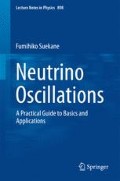Abstract
Neutrinos are produced and detected by weak interactions. It is necessary to understand the weak interactions to calculate the energy spectrum of neutrinos generated in sources and the reaction cross section with detector materials. In this chapter, the weak interactions associated with the neutrinos are reviewed and neutrino reaction probabilities that will be used in the later sections are calculated. Starting from the wave function of the massless left-handed neutrinos, the neutrino-associated parts of the standard model Lagrangian are introduced. Based on the Lagrangian, the general matrix element for the four fermion interactions that include neutrino is formulated. The spectra of neutrinos produced in the pion decay, muon decay, \(\upbeta \) decay, and the neutrino detection cross section via \({\nu } e\) elastic scatterings and inverse beta decay are quantitatively calculated.
Access this chapter
Tax calculation will be finalised at checkout
Purchases are for personal use only
Notes
- 1.
Neutrinos are treated as Dirac particle in this book unless otherwise specified.
- 2.
For neutrinos, the flavor eigenstate and mass eigenstate are identical \(({\nu }' = \nu )\) in the standard and \(f'_D\) and \(f_D\) can be interpreted equivalently.
- 3.
\(g_W = g/\sqrt{2}\), \(g_Z =g/2\cos {\uptheta }_W\), where \(g\) is the SU(2) gauge coupling constant.
- 4.
Actually the two quarks in the pion are in a bound state and the free wave functions can not be used. Nevertheless, this graphical view is useful to understand various properties of the pion decay.
- 5.
If the neutrino has a finite mass \(m_{{\nu }}\), the energies and the momentum are \(E_{{\nu }} = \frac{m_{{\uppi }}^2-m_l^2+m_{{\nu }}^2}{2m_{{\uppi }}}\), \(E_l = \frac{m_{{\uppi }}^2+m_l^2-m_{{\nu }}^2}{2m_{{\uppi }}}\) and \(p=\frac{\sqrt{((m_{\uppi } - m_{\nu })^2 -m_l^2)((m_{\uppi } + m_{\nu })^2 -m_l^2)}}{2m_{\uppi }}\).
- 6.
See Sect. 8.1.6 and the solution of the Problem 13.9 in [4, Chap. 1].
Author information
Authors and Affiliations
Corresponding author
Rights and permissions
Copyright information
© 2015 Springer Japan
About this chapter
Cite this chapter
Suekane, F. (2015). Neutrinos and Weak Interactions in the Standard Model. In: Neutrino Oscillations. Lecture Notes in Physics, vol 898. Springer, Tokyo. https://doi.org/10.1007/978-4-431-55462-2_2
Download citation
DOI: https://doi.org/10.1007/978-4-431-55462-2_2
Published:
Publisher Name: Springer, Tokyo
Print ISBN: 978-4-431-55461-5
Online ISBN: 978-4-431-55462-2
eBook Packages: Physics and AstronomyPhysics and Astronomy (R0)

